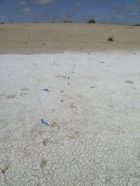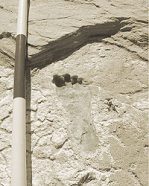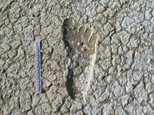Stone Age sole survivors
Researchers have uncovered the largest known collection of ancient human footprints.
By Emily Sohn
The people who walked on a muddy lakeshore in southeastern Australia surely never suspected that their footprints would stick around for 20,000 years.
Yet, at least 124 of their prints still exist, say a group of scientists who uncovered the barefoot impressions. It’s the largest collection of Stone Age footprints ever discovered, and analyses are giving insight into the lives and bodies of the people who left them behind.
 |
|
Footprints that probably belong to a Stone Age person disappear under an Australian dune (top).
|
| Matthew Cupper |
The footprints were found in August 2003 during a general survey of the area’s archaeology. Eighty-nine footprints were already exposed. A little digging in the soil turned up another 35.
To figure out when feet last touched ground, the scientists aimed laser light on grains of sand taken from sediment just above and just below the impressions. These sediments, they figured, had to be at the surface when the people walked across the lakeshore.
Light that bounced back from the sand grains provided information that allowed the scientists to estimate the age of the sand. (In particular, they looked at how much radioactivity had built up in the sediment.) They dated the footprints to between 23,000 and 19,000 years ago.
 |
|
A Stone Age footprint found in the Willandra Lakes region of Australia.
|
| Matthew Cupper |
The shapes and sizes of the prints and the distances between them allowed the scientists to figure out about how many people were there, how tall they were, and roughly how old they might have been at the time.
Seventy-six of the impressions, they found, belonged to eight people. Six were fairly large adults. (Two measured more than 6 feet tall.) Two were younger. The adults ran across the muddy plain in one direction. A teenager and a child moved in the same general direction, but they walked.
 |
|
In an impression of an adult’s right foot, the toes stand out.
|
| Matthew Cupper |
Comparisons of the prehistoric strides with the strides of similarly sized, modern distance runners showed that the largest of the adults was running at a speed of up to 12 miles per hour. That’s about the speed of a fit runner today.
Near the footprints, the scientists found many round indentations, measuring about 2 inches across. These could be the marks of weapons or walking sticks. Long, shallow grooves suggest that the people were also dragging poles.
The group may have been moving from one lake or camp to another, the scientists speculate. Or perhaps they were out hunting or fishing—or even picnicking.—E. Sohn
Going Deeper:
Bower, Bruce. 2006. Stone age footwork: Ancient human prints turn up down under. Science News 169(Jan. 7):3. Available at http://www.sciencenews.org/articles/20060107/fob1.asp .
You can learn more about the Willandra Lakes region of Australia at www.deh.gov.au/heritage/worldheritage/sites/willandra/ (Government of Australia).







